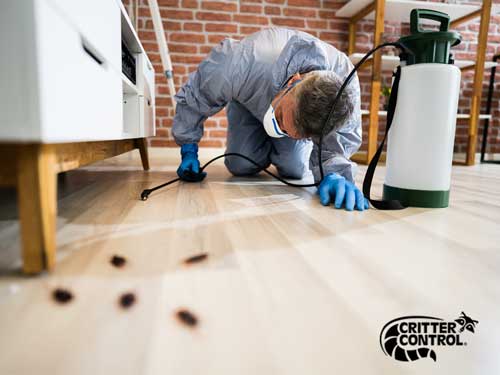Professional A1 Charlotte Bed Bug Exterminator - Top Quality Solution Guaranteed
Wiki Article
Bed Pest Treatment Malfunction: Comparing Chemical Vs. Non-Chemical Solutions
In the realm of parasite control, particularly when taking care of the persistent problem of bed pests, the option in between chemical and non-chemical treatment options can be a pivotal one. Both methods supply distinct advantages and drawbacks, influencing variables such as effectiveness, safety considerations, and general price. By analyzing the nuanced details of each approach, a more clear understanding of which course to seek in dealing with a bed insect infestation can be achieved.Performance of Chemical Therapies
Chemical treatments for bed bug problems have been commonly recognized for their powerful and quick efficiency in eliminating these bugs. When thinking about the efficiency of chemical treatments, it is crucial to recognize that they can give a fast and detailed service to a bed insect problem.Furthermore, chemical therapies have the advantage of supplying residual effects, meaning that they can remain to get rid of bed insects also after the preliminary application. This recurring activity is particularly beneficial in combating any type of prospective re-infestations. Additionally, the fast activity of chemical treatments can bring relief to people dealing with extreme bed insect problems, allowing them to restore control of their space swiftly.
Safety And Security Worries With Chemical Solutions
When making use of chemical solutions for bed pest treatment is guaranteeing the safety of residents and the environment,One crucial facet that needs careful consideration. While chemical treatments can be effective in removing bed bugs, they may present threats if not taken care of properly. Among the primary safety worries with chemical remedies is the potential injury they can create to human wellness. Exposure to specific chemicals utilized in bed insect therapies can lead to respiratory problems, skin irritability, or various other damaging responses, specifically in people with pre-existing conditions or sensitivities. In addition, incorrect application or dosage of chemical pesticides can result in hazardous deposits sticking around in the cured area, positioning long-lasting health dangers to passengers.Additionally, the ecological effect of chemical solutions is another significant consideration. Some pesticides made use of in bed bug treatments may be damaging to useful insects, wild animals, and ecosystems if they seep right into the dirt or water systems. It is necessary to use chemical therapies carefully, complying with safety standards, and taking into consideration less toxic choices to mitigate these dangers and guarantee the reliable and risk-free monitoring of bed insect problems.
Advantages of Non-Chemical Methods
Considering the possible safety worries and environmental impact connected with chemical solutions for bed pest treatment, discovering non-chemical strategies presents a promising option with a number of unique advantages. Non-chemical treatments are ecologically friendly, as they do not add to air or water pollution, making them a lasting selection for pest control.Additionally, non-chemical services can be effective in targeting bed insects, consisting of hard-to-reach areas where chemical therapies may not permeate. Methods such as warmth treatment, vacuuming, vapor cleaning, and bed mattress coverings give complete eradication without making use of damaging chemicals. Moreover, non-chemical techniques can be much less turbulent, requiring minimal preparation and allowing for quicker reentry into treated locations. Generally, deciding for non-chemical bed bug therapy approaches not just focuses on safety and security and environmental management however why not look here likewise ensures thorough and effective pest control.
Limitations of Non-Chemical Treatments

In addition, non-chemical treatments often call for multiple applications to achieve effective elimination. This can be taxing and might not constantly guarantee total removal of all bed insects and their eggs, specifically in hard-to-reach or covert places.
Additionally, the success of non-chemical therapies greatly depends on appropriate execution and thoroughness, Visit Your URL which can be testing for people without specialist knowledge. Inadequate application of non-chemical approaches may result in incomplete removal, leading to relentless problems and the need for extra therapies.
As a result, while non-chemical treatments have their benefits, it is important to acknowledge these constraints and consider them when identifying the most reliable method for managing bed bug problems.
Expense Comparison: Chemical Vs. Non-Chemical Options
Provided the restrictions connected with non-chemical treatments, a necessary element to assess in the context of bed insect administration is the price comparison between chemical and non-chemical alternatives. Chemical treatments generally include the application of pesticides by professionals, which can vary from $250 to $900 per room, depending upon the seriousness of the problem and the size of the area to be dealt with. In comparison, non-chemical therapies like heat treatment or heavy steam can be much more pricey, with expenses varying from $1,000 to $6,000 for a whole home. While the preliminary cost of chemical therapies may seem lower, multiple treatments might be required to fully get rid of the infestation, possibly boosting the overall expense. On the other hand, non-chemical read here choices might provide an extra green and sustainable option, although they can be cost-prohibitive for some people. Ultimately, when thinking about the cost of bed insect therapy choices, it is essential to weigh the ahead of time expenses versus the efficiency and long-term sustainability of the chosen approach.Verdict

Considering the potential safety problems and environmental impact linked with chemical services for bed bug treatment, exploring non-chemical methods offers a promising alternative with a number of distinct advantages.Given the constraints linked with non-chemical treatments, an important element to assess in the context of bed insect management is the price comparison between chemical and non-chemical alternatives. In comparison, non-chemical therapies like heat therapy or steam can be more expensive, with costs varying from $1,000 to $6,000 for a whole home. While the first cost of chemical therapies might appear lower, several therapies might be required to completely eradicate the problem, potentially raising the total price.In conclusion, when contrasting chemical and non-chemical bed insect treatment alternatives, it is necessary to think about efficiency, security, benefits, restrictions, and cost.
Report this wiki page